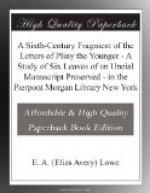[Footnote 18: An ancestor of our
manuscript must have had TRANQ.,
which was wrongly expanded to TRANQUE.]
4. Omitted M at the end of a line, omitted N at the end of a line, the omission being indicated by means of a horizontal stroke, thickened at either end, which is placed over the space immediately following the final vowel.[19] This omission may occur in the middle of a word but only at the end of a line.
[Footnote 19: This is a sign of antiquity. After the sixth century the M or Nstroke is usually placed above the vowel. The practice of confining the omission of M or N to the end of a line is a characteristic of our very oldest manuscripts. Later manuscripts omit M or N in the middle of a line and in the middle of a word. No distinction is made in our manuscript between omitted M and omitted N. Some ancient manuscripts make a distinction. Cf. Traube, Nomina Sacra, pp. 179, 181, 183, 185, final column of each page; and W.M. Lindsay, Notae Latinae, pp. 342 and 345.]
[Sidenote: Authenticity of the six leaves]
The sudden appearance in America of a portion of a very ancient classical manuscript unknown to modern editors may easily arouse suspicion in the minds of some scholars. Our experience with the “Anonymus Cortesianus” has taught us to be wary,[20] and it is natural to demand proof establishing the genuineness of the new fragment.[21] As to the six leaves of the Morgan Pliny, it may be said unhesitatingly that no one with experience of ancient Latin manuscripts could entertain any doubt as to their genuineness. The look and feel of the parchment, the ink, the script, the titles, colophons, ornamentation, corrections, and later additions, all bear the indisputable marks of genuine antiquity.
[Footnote 20: The fraudulent character of the alleged discovery was exposed in masterly fashion by Ludwig Traube in his “Palaeographische Forschungen IV,” published in the Abhandlungen der K. Bayerischen Akademie der Wissenschaften, III Klasse, XXIV Band, 1 Abteilung, Munich 1904.]
[Footnote 21: Cf. E.T.
Merrill, “On the use by Aldus of his
manuscripts of Pliny’s Letters,”
in Classical Philology, XIV
(1919), p. 34.]
But it may be objected that a clever forger possessing a knowledge of palaeography would be able to reproduce all these features of ancient manuscripts. This objection can hardly be sustained. It is difficult to believe that any modern could reproduce faithfully all the characteristics of sixth-century uncials and fifteenth-century notarial writing without unconsciously falling into some error and betraying his modernity. Besides, there is one consideration which to my mind establishes the genuineness of our fragment beyond a peradventure. We have seen above that the leaves of our manuscript are so arranged that hair side faces




